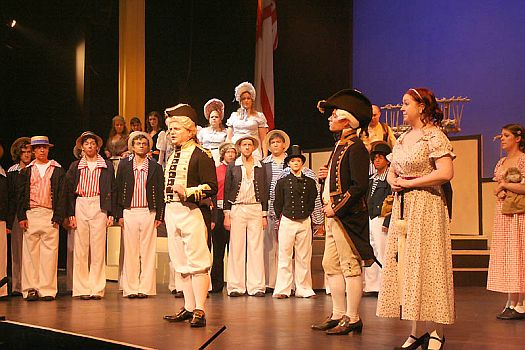 United Kingdom Gilbert & Sullivan, HMS Pinafore: Soloists, Chorus and Orchestra of Manchester University Gilbert & Sullivan Society (MUGSS), Royal Northern College of Music, Manchester, 22.2.2012 (RJW)
United Kingdom Gilbert & Sullivan, HMS Pinafore: Soloists, Chorus and Orchestra of Manchester University Gilbert & Sullivan Society (MUGSS), Royal Northern College of Music, Manchester, 22.2.2012 (RJW)
Cast:
Sir Joseph Porter: Paul O’Neill
Captain Corcoran: Seumas Begg
Ralph Rackstraw: Joel Fisher
Dick Deadeye: Ian Field
Bill Bobstay: Damion Box
Andrew Green: Bob Becket
Charlotte Christensen: Tom Tucker
Josephine: Lisa Newill-Smith
Hebe: Beth Evans
Little Buttercup: Rachael Jones
Production:
Choreographer: Caroline Meek
Musical Director: James Hendry
Director Philip Sweet

The yearly production by this long-standing group is always well-supported by those who enjoy good entertainment and the often welcome diversion to conventional staging of G & S operas set to Sullivan’s traditional scores. The director’s plan to take the action back by 100 years works nicely and brings in the opportunity to have women on deck as well as colour in the sailors’ uniforms. It now becomes the King’s Navy.
With memories of a none-to-distant production by MUGSS of Pinafore coupled with Trial by Jury I was anxious to see how they would slant this new production with an older director than for last year’s excellent Yeomen. An amusing Prelude in costume set to ‘I am the monarch of the sea’ and making reference to mobile phones had good lyrics (in fact , extra well-written but uncredited lyrics were used extensively elsewhere). A well-played overture accompanied a well choreographed on-stage routine starting with daybreak, sunrise and appropriate “All’s well”, but too much time had to be filled that resulted in repetitious yawning and stretched stage business.
A bright and exuberant opening sailors’ mixed chorus gained one’s complete attention with the excellent quality of singing that was held throughout the Act. The entrance of Buttercup made use of a coracle-styled barge. She soon gained her feet to give a strong performance, and played her role flirtatiously to good effect. Corcoran gave a believably authoritative performance that nicely contrasted with the turn of tables that takes place in Act II.
Sir Joseph was characterised as a stuffily dour individual who had good stage presence yet lacked elements of comedy. Hebe used her character to give a much-needed sprinkling of humour to the show in the interpolated and welcomed Act II dialogue with her father and Sir Joseph. She amused the audience when miming her Lady Jane style retort, “Crushed again”. The usual MUGSS’s breezy humour was generally lacking in this production since none of the usual stage antics were provided. This was partly compensated for by a Garfield ship’s cat (slightly robotic). Both Josephine and Ralph were strong in performance and suitably paired: Josephine sang with excellent diction and soared admirably to her top notes while Ralph provided a pleasing timbre and nice vibrato. The trio, ‘A British tar’, was superb and nicely balanced.
A delightful diversion was the interpolated ‘Eat, drink and be gay’ chorus taken from The Sorcerer finale. Some may have noticed the subtlety with which Mike Harris interestingly sneaked into the band parts with music that was abandoned after 1884. It is intriguing corners like this that G&S aficionados enjoy.
The soloists were strong and the ensemble singing was truly excellent throughout, the chorus often finishing numbers on an ending note an octave higher than written.
I liked the Pineapple Poll cheeked girls who worked industriously in the background. Some detailed routines by choreographer, Caroline Meek, point to the care of planning and quality of rehearsal. The look of the set was good and the use of different levels helped to frame good groupings. A pair of authentic looking cannons flanked the sides down stage and gave a good effect. Cannon booms were perhaps overdone and one didn’t understand the reason for using maroons as a spectacle. Lighting was generally good and a believable frozen stage effect was used during the Act I finale: but a similar unsubtle change for Buttercup at the start of the Act didn’t work. To help maximise an effect, cues are best complementing a change in music mood.
The orchestra was excellent and James Hendry set a lively pace throughout, introducing a few extra rallentandos that worked for my ears. However, one chorus number was deliberately taken slowly, which tended to lose the legato charm of its melody and rhythm.
An Interlude piece, The Sailors’ Farewell, was used to preface the start of Act II. It was more a scene in which there was talk of the ship being put out of service and scrapped. It did give a worthwhile opportunity to include a nimble hornpipe routine by Joey Dexter (taken from Ruddigore) to the delightful accompaniment of an on-stage violinist and flautist. The finale of The Gondoliers, with changed lyrics, was used for farewells to the on-board women. At this point one was reminded that the sailor’s shirts were modelled on those worn by gondoleri. A highlight of this scene was the inclusion of the superbly sung Mozartian trio, Soave sia il vento, by Harriet Mulchrone, Laura Hill and Constant Goddard.
I notice from the programme that The Grand Duke is to be performed in May 2013 (details on the MUGSS’s website). We wish the group well for their appearance at Buxton Festival later in the year when this production gets a second airing.
Raymond J Walker